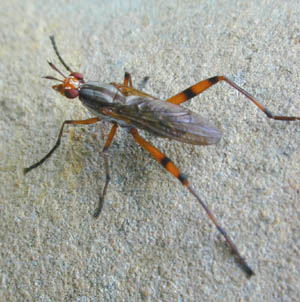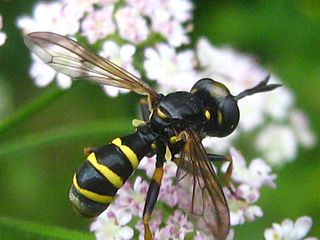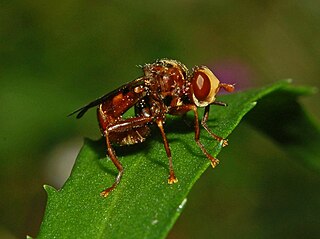Related Research Articles

The Acalyptratae or Acalyptrata are a subsection of the Schizophora, which are a section of the order Diptera, the "true flies". In various contexts the Acalyptratae also are referred to informally as the acalyptrate muscoids, or acalyptrates, as opposed to the Calyptratae. All forms of the name refer to the lack of calypters in the members of this subsection of flies. An alternative name, Acalypterae is current, though in minority usage. It was first used by Pierre-Justin-Marie Macquart in 1835 for a section of his tribe Muscides; he used it to refer to all acalyptrates plus scathophagids and phorids, but excluding Conopidae.

The Conopidae, usually known as the thick-headed flies, are a family of flies within the Brachycera suborder of Diptera, and the sole member of the superfamily Conopoidea. Flies of the family Conopidae are distributed worldwide in all the biogeographic realms except for the poles and many of the Pacific islands. About 800 species in 47 genera are described worldwide, about 70 of which are found in North America. The majority of conopids are black and yellow, or black and white, and often strikingly resemble wasps, bees, or flies of the family Syrphidae, themselves notable bee mimics. A conopid is most frequently found at flowers, feeding on nectar with its proboscis, which is often long.
Sicu or SICU may refer to:

Siku is a traditional Andean panpipe. This instrument is the main instrument used in a musical genre known as sikuri. It is traditionally found all across the Andes but is more typically associated with music from the Kollasuyo, or Aymara speaking regions around Lake Titicaca. Historically because of the complicated mountain geography of the region, and due to other factors, in some regions each community would develop its own type of siku, with its own special tuning, shape and size. Additionally each community developed its own style of playing. Today the siku has been standardized to fit in with modern western forms of music and has been transported from its traditional roots.
Otto Kröber was a German entomologist specialising in Diptera. He worked mainly on Tabanidae, Omphralidae, Therevidae and Conopidae.

Conops is a genus of flies from the family Conopidae. The larvae of Conops are parasitic on bees, especially bumblebees. Adults feed on nectar.

Conopini is a tribe of the flies family Conopidae. The larvae of species are parasitic on bees, especially bumblebees. Most adults will feed on nectar.

Sicus ferrugineus is a species of fly from the genus Sicus in the family Conopidae.

Myopa buccata is a species of fly from the genus Myopa in the family Conopidae. Their larvae are endoparasites of bumble bees of the genus Bombus. It is common throughout much of Europe.

Sicus is a genus of flies from the family Conopidae.

Zodion is a large genus of flies from the family Conopidae.

Zodionini is a tribe of flies from the family Conopidae.

Myopinae is a subfamily of flies from the family Conopidae.

Sicini is a tribe of flies from the family Conopidae.

Myopini is a tribe of flies from the family Conopidae.

Conops vesicularis is a species of fly from the genus Conops in the family Conopidae. Their larvae are endoparasites of bees and wasps.

Conopinae is a subfamily of flies from the family Conopidae.

Leopoldius signatus is a species of fly from the genus Leopoldius in the family Conopidae.

Myopa dorsalis is a species belonging to the family Conopidae subfamily Myopinae.
References
- ↑ Smith, K.G.V. (1969). Diptera: Conopidae. Handbooks for the Identification of British Insects. Vol. 10 pt 3a. Royal Entomological Society of London. pp. 19 pp.